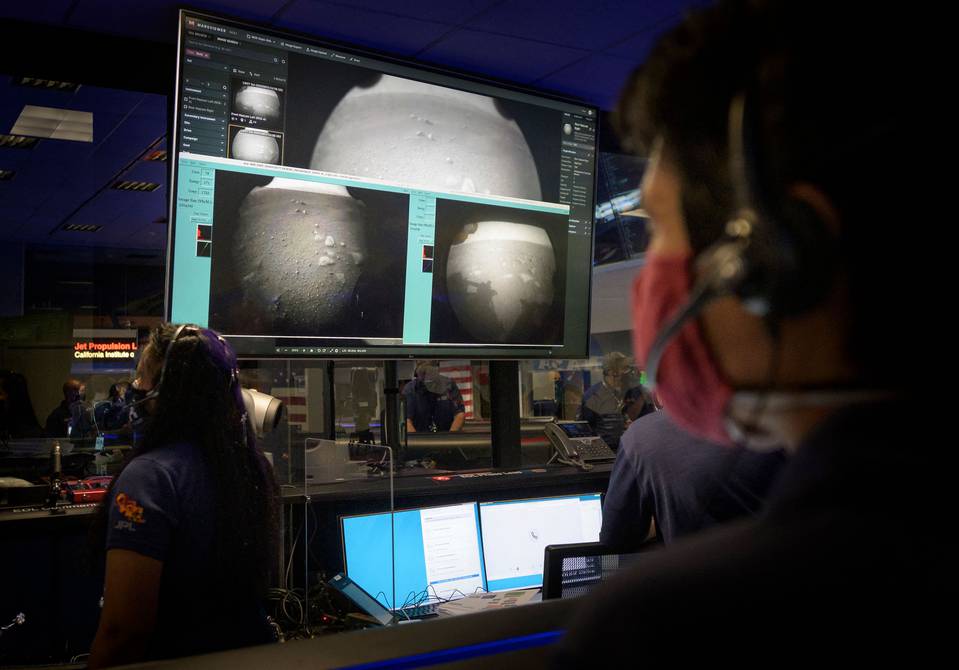In the coming months the rover will attempt to collect about 30 rocks and soil samples that will be sent back to Earth in the 2030s.
This Thursday NASA enthusiastically confirmed that its Perseverance space vehicle landed on the surface of Mars after overcoming the dangerous phase of descent on the red planet known as “the seven minutes of terror.”
“It is confirmed that it made landfall,” Mission Chief Swati Mohan said at 3:55 p.m. ET, after which the Propulsion Craft Laboratory operations headquarters erupted in applause.
The process itself had been completed more than 11 minutes earlier, the time it takes for the signal to return to Earth.
NASA posted on the Perseverance Twitter account a black and white photo taken from the device, showing the grainy surface of the Jezero crater in the northern hemisphere of Mars.
This vehicle is the fifth to land on Mars after a first successful mission in 1997. All the spacecraft that have succeeded so far have been American projects.
Perseverance is the size of a city truck and weighs a ton. It is equipped with a two-meter robotic arm and has 19 cameras, two microphones and state-of-the-art instruments.
A great step for the study of the universe
Its multi-year mission is to study this surface for evidence of microbes that may have existed billions of years ago, when conditions were warmer and more humid in this area than today.
In the coming months the rover will attempt to collect some 30 rocks and soil samples that will be sent back to Earth in the 2030s for analysis.
“The question of whether there was life beyond Earth is one of the most fundamental and essential questions we can ask ourselves,” said NASA geologist Katie Stack Morgan.
For this, the ship will be in charge of capturing images, collecting samples and capturing sounds -such as that caused by strong winds- during its mission, according to information from NASA, which also mentions that the sound forms there are different from those on Earth, because it has an atmosphere with a higher density and a different composition. For this reason the emission and propagation of sounds is affected.
The sounds will be captured through a microphone installed in the SuperCam, high on the Perseverance mast, which will also record the audio from the laser that the space vehicle will use to hit the stones and detect their properties.
“Perseverance’s sophisticated scientific instruments will not only aid in the search for fossilized microbial life, but will also expand our knowledge of Martian geology and its past, present and future,” the Caltech Mars 2020 project scientist said in previous weeks. Pasadena, Ken Farley.
To that end, Perseverance has had seven months of space travel, decades of work, and billions of dollars invested to answer a single question: Did life ever exist anywhere other than Earth? NASA tries to answer this question with ‘landing’.
Perseverance is the largest and most complex vehicle ever sent to Mars. Built at the Jet Propulsion Laboratory in California, it weighs one ton and is equipped with a six-foot robotic arm and 19 cameras.
“Stroke of luck?”
Researchers believe that the Jezero crater, where Perseverance ‘landed’, housed a lake about 50 km wide for more than 3.5 billion years.
“We have very strong evidence that Mars may have supported life in the past,” Ken Williford, deputy director of the mission, said Wednesday. “The question is: is the Earth an anomaly, a stroke of luck?”
Scientists look for what they call biosignatures: traces of microbial life that “can take all kinds of forms,” like “chemicals” or “environmental changes,” said Mary Voytek, director of NASA’s astrobiology program.
“Astrobiologists have dreamed of this mission for decades,” she enthusiastically added.
“Either we find life, and that would be an exceptional find, or we will not, (…) and that will imply that not all habitable environments are inhabited,” warned Ken Farley.

